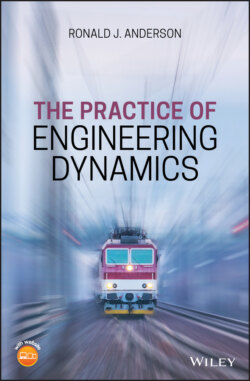Читать книгу The Practice of Engineering Dynamics - Ronald J. Anderson - Страница 4
List of Illustrations
Оглавление1 Chapter 1Figure 1.1 A vector changing with time.Figure 1.2 Even 2D problems are 3D.Figure 1.3 A rigid rod rotating about a fixed point.Figure 1.4 A slider in a slot.Figure 1.5 A three dimensional robot.Figure 1.6 Relative position vectors.Figure 1.7 The velocity and acceleration components of the slider.
2 Chapter 2Figure 2.1 A slider in a slot.Figure 2.2 Creating the Free Body Diagram of the slider.Figure 2.3 A single particle in a rigid body.Figure 2.4 Free body diagram of a single particle in a rigid body.Figure 2.5 A single mass system to help interpret inertia properties.Figure 2.6 Term 1 – a product of inertia term.Figure 2.7 Term 2 – a product of inertia term.Figure 2.8 Term 3 – a moment of inertia term.Figure 2.9 An American football in flight.Figure 2.10 A cylinder on a wedge.Figure 2.11 FBDs of the cylinder and the wedge.Figure 2.12 A spinning top.Figure 2.13 A bicycle.Figure 2.14 The “tipped” top.Figure 2.15 The bicycle turning to the right.
3 Chapter 3Figure 3.1 A mass on a wire.Figure 3.2 Gravitational force acting on a mass.Figure 3.3 Spring force acting on a mass.Figure 3.4 A linear viscous damper.Figure 3.5 A single particle in a rigid body.Figure 3.6 2D rigid body example.Figure 3.7 2D rigid body potential energy.
4 Chapter 4Figure 4.1 A simple pendulum.Figure 4.2 The equilibrium solutions for the 2D example.Figure 4.3 An eccentric rotating body.Figure 4.4 The constant acceleration case.
5 Chapter 5Figure 5.1 Stability response types.Figure 5.2 Linearization.
6 Chapter 6Figure 6.1 The higher frequency mode for the two degrees of freedom system (...Figure 6.2 The lower frequency mode for the two degrees of freedom system (0...Figure 6.3 A rigid rod supported on springs.Figure 6.4 Undamped mode shapes for the rigid rod supported on springs.Figure 6.5 Nodal points.Figure 6.6 Damped mode shapes for the rigid rod supported on springs.Figure 6.7 Calculating the damping ratio from the location of an eigenvalue....Figure 6.8 Waveforms for different percent damping.
7 Chapter 7Figure 7.1 A linear system with two masses.Figure 7.2 Amplitude response of mass 1.Figure 7.3 Phase response of mass 1.Figure 7.4 Amplitude response of mass 2.Figure 7.5 Phase response of mass 2.Figure 7.6 Seismic disturbance of a system.Figure 7.7 A measured variable plotted versus time.Figure 7.8 DFT component amplitudes.Figure 7.9 Component mean‐square values.Figure 7.10 The cumulative mean‐square value.Figure 7.11 Cumulative mean‐square curve for the example system.Figure 7.12 PSD for the example system.
8 Chapter 8Figure 8.1 The pendulum.Figure 8.2 Predicted results for the sample time domain simulation.Figure 8.3 Graphical representation of Euler's method.Figure 8.4 Solution errors as a function of time step.Figure 8.5 The midpoint method.Figure 8.6 Structure of a simulation program.
9 Chapter 9Figure 9.1 A measured variable plotted versus time.Figure 9.2 The square of plotted versus time.Figure 9.3 The example function, , plotted versus time.Figure 9.4 The DFT amplitudes of the example function, , plotted versus fre...Figure 9.5 Aliasing.Figure 9.6 The folding frequency.Figure 9.7 Aliased DFT results.Figure 9.8 The DFT for the first example (no leakage).Figure 9.9 The DFT for the second example (leakage).Figure 9.10 CFT approximation to the square wave.Figure 9.11 The Hanning window.Figure 9.12 The data from Equation 9.83.Figure 9.13 The windowed data.Figure 9.14 The DFT for the second example with windowing.
10 1Figure A.1 Figure A.2 Figure A.3 Figure A.4 Figure A.5 Figure A.6 Figure A.7 Figure A.8 Figure A.9 Figure A.10 Figure A.11 Figure A.12 Figure A.13 Figure A.14 Figure A.15 Figure A.16 Figure A.17 Figure A.18 Figure A.19 Figure A.20 Figure A.21 Figure A.22 Figure A.23
11 2Figure B.1 Parallel axis theorem.
12 4Figure D.1 Three data points and two least squares curve fits.
